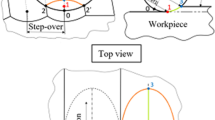Abstract
This paper presents a procedure for the evaluation of maximum surface roughness using the ridges analysed in part 1 of this paper. Maximum surface roughness is predicted for the plane cutting mode of ball-end milling. Two types of cutting modes, i.e., unidirectional mode and bidirectional mode, are investigated. The various cutting conditions in plane cutting are simplified employing the concept of the path interval ratio, fp/ft. In addition, mathematical expressions for calculating maximum surface roughness have been described for each case. The predicted results show that the geometrical surface roughness of the bidirectional mode is usually larger than that of the unidirectional mode differing from the results of the conventional roughness model. Maximum roughness and the shapes of the cut remainder are affected by path interval, feedrate and cutting mode. Experiments are carried out at various cutting conditions for both cutting modes. A high level of agreement between the expected surface roughness and measured value confirms the validity of the proposed method.
Similar content being viewed by others
References
Kim BH, Chu CN (1999) Texture prediction of milled surface using texture superposition method. Comput Aided Des 31(1):485–484
Elbestawi MA, Ismail F, Yuen KM (1994) Surface topology characterization in finish milling. Int J Mach Tools Manuf 34(2):245–255
Zhang GM, Kapper SG (1991) Dynamics generation of machined surfaces. Part 2: Construction of surface topography. ASME J Eng Ind 113(2):145–153
Rosen BG (1993) Representation of three-dimensional surface topology in CAD-systems and image processing software. Int J Mach Tools Manuf 33(1):307–320
Yang MY, Sim CG (1993) Reduction of machining errors by adjustment of feedrates in ball-end milling process. Int J Prod Res 31(1):665–689
Park SH, Jun YT, Lee CW, Yang MY (1993) Determining the cutting conditions for sculptured surface machining. Int J Adv Manuf Technol 8(2):61–70
Spence AD, Altintas Y (1994) A solid modeller based milling process simulation and planning system. ASME J Eng Ind 116(2):61–69
Wang WP (1998) Solid modeling for optimizing metal removal of three-dimensional NC end milling. J Manuf Sys 7(1):57–65
Mounayri HE, Spence AD, Elbestawi MA (1998) Milling process simulation – a generic solid modeller based paradigm. ASME J Manuf Sci Eng 120(3):120–221
Lin RS, Koren Y (1996) Efficient tool-path planning for machining free-form surfaces. ASME J Eng Ind 118(2):20–28
Suresh K, Yang DCH (1994) Constant scallop-height machining of free-form surfaces. ASME J Eng Ind 116(3):253–259
Han Z, Yang DCH (1999) Iso-photo based tool-path generation for machining free-form surfaces. ASME J Eng Ind 121(9):656–664
Feng HY, Li H (2001) Constant scallop-height tool path generation for three-axis sculptured surface machining. Comput Aided Des 34(6):647–654
Lo CC, Lin RS (2001) An improved method for scheduling the tool paths for three-axis surface machining. Int J Mach Tools Manuf 41(1):133–147
Lee SG, Yang SH (2002) CNC tool-path planning for high-speed high resolution machining using a new tool-path calculation algorithm. Int J Adv Manuf Technol 20(3):326–333
Zhao X, Tsutsumi M, Koreta N, Ge D, Chen L (1996) Determination of optimum tilting angle of ball-end mill in 5-axis control machining – determination based on finished surface roughness and application of neural network. J Jpn Soc Precis Eng 62(5):1019–1023 [in Japanese]
Zhao X, Tsutsumi M, Koreta N, Ge D (1997) Determination of optimum tilting angle of ball-end mill in 5-axis control machining – in the case of spherical surface machining based on finished surface roughness. J Jpn Soc Precis Eng 63(5):992–996 [in Japanese]
Zhao X, Koreta N, Tsutsumi M (1998) Surface roughness generated by ball-end mill on five-axis controlled machining centers. J Jpn Soc Precis Eng 64(10):1826–1830 [in Japanese]
Saito A, Zhao X, Tsutsumi M (2000) Control of surface texture of mold generated by ball-end milling. J Jpn Soc Precis Eng 66(1):419–423 [in Japanese]
Saito A, Zhao X, Tsutsumi M (2000) A method for generating regular patterns on a curved surface by ball-end milling. J Jpn Soc Precis Eng 66(10):1963–1967 [in Japanese]
Author information
Authors and Affiliations
Corresponding author
Rights and permissions
About this article
Cite this article
Jung, TS., Yang, MY. & Lee, KJ. A new approach to analysing machined surfaces by ball-end milling, part II:. Int J Adv Manuf Technol 25, 841–849 (2005). https://doi.org/10.1007/s00170-003-1931-4
Received:
Accepted:
Published:
Issue Date:
DOI: https://doi.org/10.1007/s00170-003-1931-4




